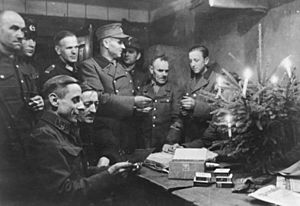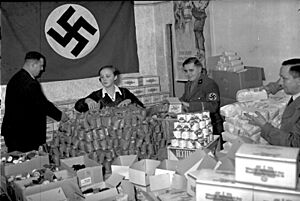Christmas in Nazi Germany facts for kids
During the time of Christmas in Nazi Germany, the celebration was allowed. However, the Nazi government tried to change this Christian holiday to fit their own ideas, called Nazi ideology. Some Nazis had problems with Jesus being from a Jewish background and with celebrating his birth as the Jewish Messiah. This went against their beliefs about race.
From 1933 to 1945, some government leaders tried to remove Christian parts of Christmas from public celebrations. Instead, they focused on older, pre-Christian traditions of the festival. But churches and private families still celebrated Christmas in the traditional Christian way.
How Christmas Changed Under the Nazis

Nazi thinkers said that the Christian parts of Christmas were added later to older German traditions. They claimed that Christmas Eve was not originally about the birth of Jesus Christ. Instead, they said it celebrated the winter solstice and the "rebirth of the sun." They also claimed the swastika was an ancient symbol of the Big Dipper constellation.
They even said that Santa Claus was a Christian version of the old Germanic god Odin, also known as Wotan. So, holiday posters showed Odin as the "Christmas or Solstice man." He was shown riding a white horse, with a thick grey beard and a slouch hat, carrying a bag of gifts. The traditional crèche (a display of Jesus's birth) was replaced. Instead, people were encouraged to have a garden with wooden toy deer and rabbits. Mary and Jesus were shown as a blonde mother and child.
The Christmas tree was also changed. Its traditional names, Christbaum (Christ tree) or Weihnachtsbaum (Christmas tree), were changed in the news to "fir tree," "light tree," or "Jul tree." The star on top of the tree was sometimes replaced with a swastika, a Germanic sun wheel, or a sig rune. Even tree lights were sometimes shaped like swastikas. At the height of the Nazi movement, there was an effort to replace the idea of Jesus's coming with the coming of Adolf Hitler, who they called the "Saviour Führer."
Christmas carols were also changed. The words to "Silent Night" were changed to remove any mention of God, Christ, or religion. Words were also changed in the hymn "Unto Us a Time Has Come" to remove references to Jesus. A modified version of this hymn was still used for several years after the war. The most popular carol promoted by the Nazis was "Exalted Night of the Clear Stars" (Hohe Nacht der klaren Sterne) by Hans Baumann. This song replaced Christian ideas with Nazi ideas about race. It was popular even after the Nazis fell and is sometimes still sung today.
Shop catalogues for children's toys during the holidays featured chocolate SS soldiers, toy tanks, fighter planes, and machine guns. As a special gift, Heinrich Himmler often gave SS members a Julleuchter ("Yule lantern"). This was a fancy Germanic candlestick, and some were even made at the Dachau concentration camp. Housewives were told to bake biscuits for their children in the shape of birds, wheels, and swastikas.
By 1944, the effort to remove Christian influences from Christmas became less important. The government focused more on the war. In 1944, public Christmas celebrations became a day to remember Germany's soldiers who had died in the war.
Why Some People Disagreed
Even though many Germans accepted the Nazis' new version of Christmas, some people did not like it. Reports from the National Socialist Women's League said that there were problems when Nazi leaders pushed too hard to stop religious celebrations. This led to "much doubt and discontent."
Church leaders were among those who did not agree with changing Christmas. Reports from Düsseldorf said that the clergy used Christmas to promote women's clubs and encourage people to join. The Catholic clergy even warned that any woman who joined the National Socialist Women's League would be excommunicated (kicked out of the church). Some religious women also refused to go to Christmas events organized by the National Socialist Women's League.
See also
 In Spanish: Navidad en la Alemania nazi para niños
In Spanish: Navidad en la Alemania nazi para niños
- Kirchenkampf
- Religion in Nazi Germany
- Weihnachten
- Winterhilfswerk


